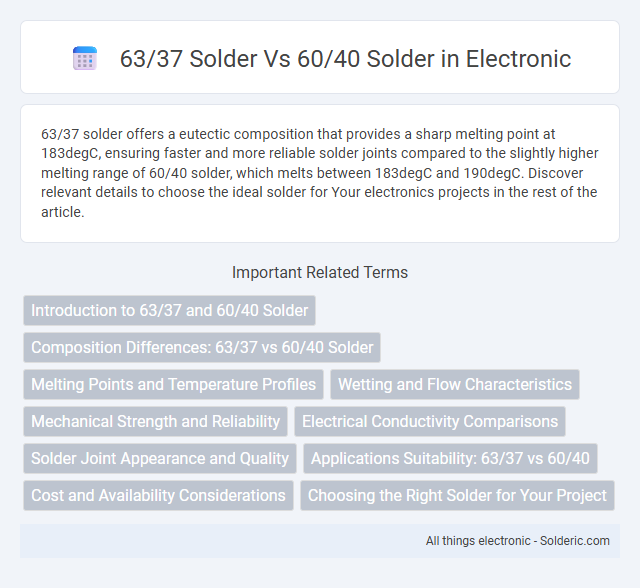63/37 solder offers a eutectic composition that provides a sharp melting point at 183degC, ensuring faster and more reliable solder joints compared to the slightly higher melting range of 60/40 solder, which melts between 183degC and 190degC. Discover relevant details to choose the ideal solder for Your electronics projects in the rest of the article.
Comparison Table
| Feature | 63/37 Solder | 60/40 Solder |
|---|---|---|
| Composition | 63% Tin (Sn), 37% Lead (Pb) | 60% Tin (Sn), 40% Lead (Pb) |
| Melting Point | 183degC (Eutectic - melts at a single temperature) | 183-190degC (Non-eutectic - has a melting range) |
| Melting Characteristics | Sharp melting point; solid to liquid transition without pasty phase | Melts over a temperature range; exhibits a pasty phase |
| Solder Joint Quality | Smoother, more reliable joints due to eutectic nature | Good joints but may show grain structure due to pasty phase |
| Applications | Preferred for precision electronic soldering, critical joints | Common in general electronics and plumbing |
| Working Time | Shorter working time due to sharp melting | Longer working time as it gradually softens |
| Cost | Typically slightly more expensive | Generally less expensive |
Introduction to 63/37 and 60/40 Solder
63/37 solder consists of 63% tin and 37% lead, offering a eutectic composition that melts at a precise 183degC, ideal for creating sharp, reliable solder joints in electronics. In contrast, 60/40 solder contains 60% tin and 40% lead, melting over a range from approximately 183degC to 190degC, providing more flexibility but less precision in joint solidification. Electronics manufacturers often choose 63/37 solder for critical applications requiring clean, consistent performance, while 60/40 solder remains popular for general-purpose soldering due to its slightly lower cost and more forgiving melting characteristics.
Composition Differences: 63/37 vs 60/40 Solder
63/37 solder consists of 63% tin and 37% lead, offering a eutectic composition that melts sharply at 183degC, ensuring faster and more reliable solder joints. In contrast, 60/40 solder contains 60% tin and 40% lead, melting over a temperature range of 183-190degC, which can lead to longer solidification times and potential joint inconsistencies. Understanding these composition differences helps optimize Your soldering process for precision and durability in electronics assembly.
Melting Points and Temperature Profiles
63/37 solder has a eutectic melting point at 183degC, providing a sharp, single melting temperature ideal for precise temperature control during soldering. In contrast, 60/40 solder transitions through a pasty range between 183degC and approximately 190-205degC, resulting in a gradual melting process that requires careful temperature management to avoid cold joints. Your choice should consider the specific thermal profile needs of your soldering application for optimal joint reliability.
Wetting and Flow Characteristics
63/37 solder exhibits superior wetting and flow characteristics compared to 60/40 solder due to its eutectic composition, allowing it to melt and solidify at a single temperature of 183degC. This results in faster, cleaner solder joints with reduced risk of cold solder defects. In contrast, 60/40 solder has a melting range between 183degC and 190degC, leading to slower flow and increased potential for imperfect wetting during electronics assembly.
Mechanical Strength and Reliability
63/37 solder, composed of 63% tin and 37% lead, offers a eutectic composition that solidifies at a single temperature, resulting in superior mechanical strength and enhanced reliability in electronic joints compared to 60/40 solder. The 60/40 solder, containing 60% tin and 40% lead, has a pasty range during solidification, which can introduce microstructural inconsistencies and potential weak points under mechanical stress. Consequently, 63/37 solder is preferred for critical applications requiring consistent mechanical performance and long-term durability.
Electrical Conductivity Comparisons
63/37 solder exhibits slightly higher electrical conductivity than 60/40 solder due to its eutectic composition, which ensures a uniform microstructure and minimal grain boundaries that can impede electron flow. The consistent melting point of 63/37 solder also results in more reliable and stable electrical connections, reducing resistance at the joints. When optimizing Your circuits for maximum efficiency, choosing 63/37 solder enhances conductivity and overall performance.
Solder Joint Appearance and Quality
63/37 solder, with its eutectic composition, provides a smooth, shiny, and uniform solder joint appearance due to its rapid solidification. In contrast, 60/40 solder cools slower, often resulting in a duller, grainier joint that can indicate potential weaknesses in mechanical strength. The consistent microstructure of 63/37 solder ensures higher joint reliability and better electrical conductivity compared to the variable crystalline formation in 60/40 solder joints.
Applications Suitability: 63/37 vs 60/40
63/37 solder, a eutectic alloy with a precise melting point of 183degC, offers superior performance in applications requiring precise thermal control and minimal joint stress, such as fine-pitch electronics and surface-mount technology (SMT). 60/40 solder, which melts over a temperature range of 183-190degC, is more versatile for general-purpose soldering, making it suitable for through-hole components and repair work where flexibility in melting is advantageous. Your choice depends on the application's thermal sensitivity and mechanical stress requirements, with 63/37 preferred for critical, high-reliability joints and 60/40 favored for broader, less precision-demanding uses.
Cost and Availability Considerations
63/37 solder generally costs more than 60/40 solder due to its higher purity and optimal eutectic properties, making it preferred for precision electronics but less common in general use. 60/40 solder is widely available and cheaper, making it a cost-effective choice for many general soldering applications despite its slightly inferior melting characteristics. Manufacturers and hobbyists often select 60/40 solder to minimize expenses while maintaining adequate performance in less critical projects.
Choosing the Right Solder for Your Project
Choosing between 63/37 solder and 60/40 solder depends on your project's need for precision and reliability. The 63/37 solder is a eutectic alloy, melting at a single temperature of 183degC, which ensures a faster, cleaner joint ideal for sensitive electronics. Your choice should balance the lower melting point and reduced bridging risk of 63/37 against the versatility and slightly higher melting range (183-190degC) of 60/40 for general-purpose soldering tasks.
63/37 solder vs 60/40 solder Infographic

 solderic.com
solderic.com